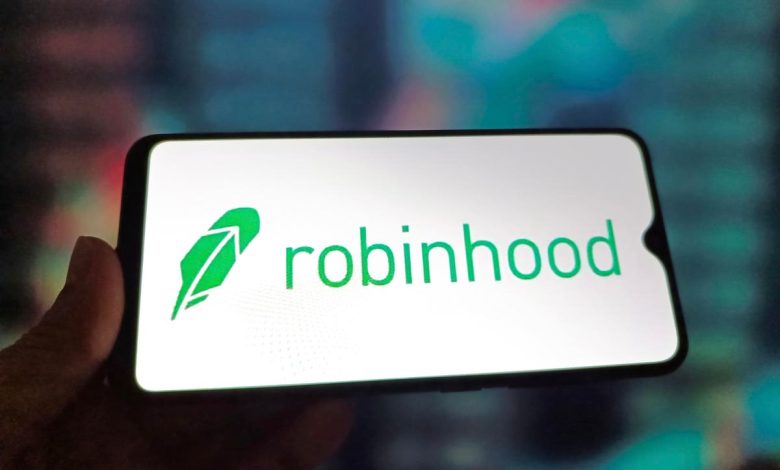How Crypto Is Powering Robinhood Stock’s Surge

SUQIAN, CHINA – JULY 5, 2025 – A Robinhood LOGO displayed on a smartphone in Suqian City, Jiangsu … More
Robinhood Markets (NASDAQ:HOOD) stock rose by nearly 26% over the last month due to several significant developments. Most notably, the company introduced tokenized stocks, which are essentially blockchain-based equity derivatives allowing the trading of over 200 U.S. stocks and ETFs by customers in the European Union. In fact, the firm is providing tokens that are tied to the valuation of privately owned companies such as OpenAI and SpaceX for E.U. clients. Additionally, the company completed its acquisition of the global cryptocurrency exchange operator Bitstamp, which grants it over 50 active licenses and registrations globally. While Robinhood has been providing crypto trading services for several years, this acquisition enables the firm to strengthen its enterprise options, enhance its lending and staking infrastructure, and offer more specialized products tailored for hedge funds, fintechs, and registered investment advisors. The market has also been increasingly focused on the crypto narrative in recent months, driven by a more positive regulatory environment and increasing support from the Trump administration, which has contributed to the stock’s performance.
So, is HOOD appealing at its current price of around $95 per share? Robinhood stock has momentum working in its favor, with robust recent growth and margins, although there are certain risks that investors need to consider. However, for investors seeking less volatility than individual stocks, the Trefis High Quality portfolio offers an alternative – having outperformed the S&P 500 and achieved returns surpassing 91% since its launch.
How Does Robinhood Markets’ Valuation Compare to The S&P 500?
When assessing the price per dollar of sales or profit, HOOD stock appears costly relative to the broader market.
• Robinhood Markets has a price-to-sales (P/S) ratio of 24.1 compared to a figure of 3.1 for the S&P 500
• Moreover, the company’s price-to-free cash flow (P/FCF) ratio stands at 74.5, while for the S&P 500, it is 20.9
• Additionally, it has a price-to-earnings (P/E) ratio of 49.5 compared to the benchmark’s 26.9
How Have Revenues for Robinhood Markets Changed in Recent Years?
Robinhood Markets’ Revenues have seen substantial growth over recent years.
• Robinhood Markets has experienced its top line grow at an average rate of 30.0% over the last 3 years (compared to an increase of 5.5% for S&P 500)
• Its revenues have grown 59.6% from $2.0 billion to $3.3 billion in the last 12 months (versus growth of 5.5% for S&P 500)
• Furthermore, its quarterly revenues grew 50.0% to $927 million in the most recent quarter from $618 million a year ago (compared to a 4.8% increase for S&P 500)
How Profitable Is Robinhood Markets?
Robinhood Markets’ profit margins are significantly higher than many companies in the Trefis coverage universe.
• Robinhood Markets’ Operating Income over the last four quarters amounted to $1.3 billion, reflecting a notably high Operating Margin of 39.0%
• Over the most recent four-quarter period, Robinhood Markets’ Net Income was $1.6 billion – signifying a notably high Net Income Margin of 48.8% (compared to 11.6% for S&P 500)
How Resilient Is HOOD Stock During A Downturn?
HOOD stock has underperformed compared to the benchmark S&P 500 index in several recent downturns. While investors are hopeful for a soft landing for the U.S. economy, what could the impacts be in the event of another recession? Our dashboard How Low Can Stocks Go During A Market Crash illustrates how key stocks performed during and after the last six market crashes.
Inflation Shock (2022)
• HOOD stock declined 90.2% from a high of $70.39 on August 4, 2021, to $6.89 on June 16, 2022, versus a peak-to-trough drop of 25.4% for the S&P 500
• The stock fully recouped to its pre-Crisis peak by June 3, 2025
• Since then, the stock has risen to a high of $97.98 on July 5, 2025
Covid Pandemic (2020)
• HOOD stock dropped 75.7% from $70.39 on August 4, 2021, to $17.11 on December 29, 2021, against a peak-to-trough decline of 33.9% for the S&P 500
• The stock fully regained its pre-Crisis peak by June 3, 2025
Putting All The Pieces Together: What It Means For HOOD Stock
In conclusion, Robinhood Markets’ performance across the discussed parameters is summarized as follows:
• Growth: Extremely Strong
• Profitability: Extremely Strong
• Financial Stability: Weak
• Downturn Resilience: Weak
• Overall: Strong
While HOOD stock appears promising, investing in a single stock comes with risks. Conversely, the Trefis High Quality (HQ) Portfolio, comprising 30 stocks, has demonstrated a history of comfortably outperforming the S&P 500 over the last four years. What accounts for this? In aggregate, HQ Portfolio stocks delivered better returns with reduced risk compared to the benchmark index; a smoother ride, as highlighted in HQ Portfolio performance metrics.





